
Puebla, also known in Spanish as Puebla de Zaragoza, formally Heroica Puebla de Zaragoza and in colonial times as Puebla de los Ángeles, is the seat of Puebla Municipality, the capital and largest city of the state of Puebla, and the second largest in colonial Mexico and the richest Catholic diocese. A colonial era planned city, it is located in (southern) Central Mexico on the main route between the capital, Mexico City, and Mexico's main Atlantic port, Veracruz—about 100 km (62 mi) east southeast of Mexico City and about 220 km (140 mi) west of Veracruz.

The Palacio de Bellas Artes is a prominent cultural center in Mexico City. It has hosted notable events in music, dance, theatre, opera and literature in Mexico and has held important exhibitions of painting, sculpture and photography. Consequently, the Palacio de Bellas Artes has been called the "Cathedral of Art in Mexico". The building is located on the western side of the historic center of Mexico City next to the Alameda Central park.

Colonia Roma, also called La Roma or simply, Roma, is a district located in the Cuauhtémoc borough of Mexico City just west of the city's historic center, and in fact is no longer a single colonia (neighbourhood) but now two officially defined ones, Roma Norte and Roma Sur, divided by Coahuila street.
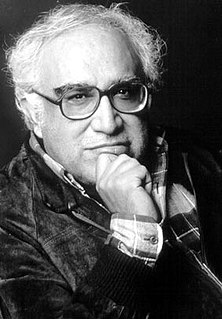
Carlos Monsiváis Aceves was a Mexican writer, critic, political activist, and journalist. He also wrote political opinion columns in leading newspapers within the country's progressive sectors. His generation of writers includes Elena Poniatowska, José Emilio Pacheco, and Carlos Fuentes. Monsiváis won more than 33 awards, including the 1986 Jorge Cuesta Prize, the 1989 Mazatlán Prize, and the 1996 Xavier Villaurrutia Award. Considered a leading intellectual of his time, Monsiváis documented contemporary Mexican themes, values, class struggles, and societal change in his essays, books and opinion pieces. He was a staunch critic of the long-ruling Partido Revolucionario Institucional (PRI), leaned towards the left-wing, and was ubiquitous in disseminating his views on radio and television. As a founding member of "Gatos Olvidados", Monsiváis wanted his and other "forgotten cats" to be provided for beyond his lifetime.

The Museo Nacional de Arte (MUNAL) is the Mexican national art museum, located in the historical center of Mexico City. The museum is housed in a neoclassical building at No. 8 Tacuba, Col. Centro, Mexico City. It includes a large collection representing the history of Mexican art from the mid-sixteenth century to the mid 20th century. It is recognizable by Manuel Tolsá's large equestrian statue of Charles IV of Spain, who was the monarch just before Mexico gained its independence. It was originally in the Zocalo but it was moved to several locations, not out of deference to the king but rather to conserve a piece of art, according to the plaque at the base. It arrived at its present location in 1979.
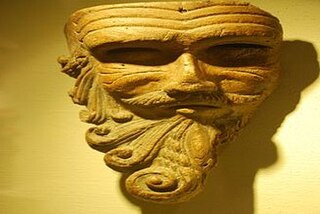
Rafael Coronel was a painter from Mexico. He was the son-in-law of Diego Rivera. His representational paintings have a melancholic sobriety, and include faces from the past great masters, often floating in a diffuse haze. There are some paintings of his own in Mexico and in other countries. In what was the convent of San Francisco De Almoloyan y De Asis, located in Zacatecas, there is a museum named after him; in this museum, his vast mask collection is shown.

The historic center of Mexico City, also known as the Centro or Centro Histórico, is the central neighborhood in Mexico City, Mexico, focused on Zócalo or main plaza and extending in all directions for a number of blocks, with its farthest extent being west to the Alameda Central. The Zocalo is the largest plaza in Latin America. It can hold up to nearly 100,000 people.

The Museo de la Historia de Ponce is a museum located in the historic Casa Salazar-Candal in the city of Ponce, Puerto Rico. The museum depicts the city's ecology, economy, architecture, government, and elements of daily life. It seeks to promote the research, conservation, and dissemination of the historic heritage of Ponce and Puerto Rico.

The Museo de la Estampa is a museum in Mexico City, dedicated to the history, preservation and promotion of Mexican graphic arts. The word “estampa” means “engraving” or “printing” refers to works which have the quality of being reproducible and include seals, woodcuts, lithography and others. The museum was created in 1986 and located in a 19th-century Neoclassical building located in the Plaza de Santa Veracruz in the historic center of the city. This building was remodeled both to house the museum and to conserve its original look.

Colonia Tabacalera is a colonia or neighborhood in the Cuauhtémoc borough of Mexico City, on the western border of the city's historic center. It was created in the late 19th century along with other nearby colonias such as Colonia San Rafael and Colonia Santa María la Ribera. From the early 1900s, it became a mixture of mansions and apartment buildings, with major constructions such as the now Monument to the Revolution and the El Moro skyscraper built in the first half of the century. By the 1950s, the area had a bohemian reputation with writers, artists, and exiles living there. These included Fidel Castro and Ernesto “Che” Guevara who met each other and began planning the Cuban Revolution here. Today, the colonia is in decline with problems such as prostitution, crime, street vending and traffic. However, the area is still home to some of the many traditional Mexican cantinas that populated it in its heyday.
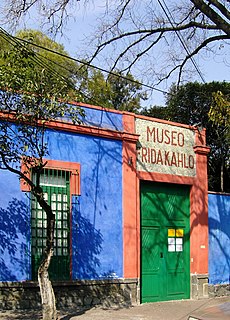
The Frida Kahlo Museum, also known as the Blue House for the structure's cobalt-blue walls, is a historic house museum and art museum dedicated to the life and work of Mexican artist Frida Kahlo. It is located in the Colonia del Carmen neighborhood of Coyoacán in Mexico City. The building was Kahlo's birthplace, the home where she grew up, lived with her husband Diego Rivera for a number of years, and where she later died in a room on the upper floor. In 1957, Diego Rivera donated the home and its contents in order to turn it into a museum in Frida's honor.

The Museo Soumaya is a private museum in Mexico City and a non-profit cultural institution with two museum buildings in Mexico City - Plaza Carso and Plaza Loreto. It has over 66,000 works from 30 centuries of art including sculptures from Pre-Hispanic Mesoamerica, 19th- and 20th-century Mexican art and an extensive repertoire of works by European old masters and masters of modern western art such as Auguste Rodin, Salvador Dalí, Bartolomé Esteban Murillo and Tintoretto. It is called one of the most complete collections of its kind.

La Lagunilla Market is a traditional public market in Mexico City, located about ten blocks north of the city's main plaza, in a neighborhood called La Lagunilla. The market is one of the largest in the city and consists of three sections: one for clothing, one for furniture and one for foodstuffs, mostly selling to lower income customers. The market is surrounded by small stores and street vendors, many specializing in furniture and dresses and other needs for formal occasions. On Sundays, the number of street vendors grows significantly, a weekly “tianguis” market called a baratillo which traditionally sells used items. One section of this baratillo has developed into a market for antiques, which has attracted higher income customers and even famous ones such as Carlos Monsiváis.
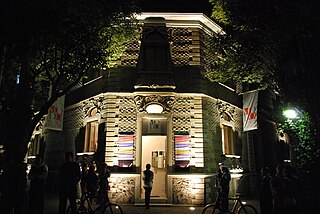
The Museo del Objeto del Objeto, or MODO, is a museum in Mexico City and the first museum in Mexico dedicated to design and communications. It was opened in 2010 based on a collection of commercial packaging, advertising, graphic arts, common devices and many other objects dating back to 1810 collected by Bruno Newman over more than forty years. The museum is dedicated to the preservation of its collection of more than 30,000 items from two centuries and to the research in the history of design and communications.

Mariana Yampolsky was one of the major figures in 20th-century Mexican photography, specializing in capturing photos of common people in everyday situations in the rural areas of the country. She was born in the United States, but came to Mexico to study art and never left, becoming a Mexican citizen in 1958. Her career in photography began as a sideline to document travels and work in the arts and politics, but she began showing her photography in the 1960s. From then until her death in 2002, her work was exhibited internationally receiving awards and other recognition both during her lifetime and posthumously.
Jesús Reyes Ferreira, (1880-1977) born José de Jesús Benjamín Buenaventura de los Reyes y Ferreira and also known as Chucho Reyes, was a self-taught artist and antiques/art collector and vendor. Reyes Ferreira began painting on crêpe paper, a delicate material not meant to last, as a way of decorating paper meant to wrap sales from his antiques/art store. The decorated paper became popular enough to be sold on its own. Although he began this activity in Guadalajara, he did not produce the bulk of his work until after he moved to Mexico City when he was 58 years old. Here he continued collecting and selling objects such as colonial art and Mexican handcrafts and folk art, being one of the early exponents for the appreciation of these objects. He also spent several hours a day painting. His work was first exhibited in 1950 with his first individual exhibition in 1967 at the Palacio de Bellas Artes after a half century of painting. As a self-taught painter, his works are relatively simple and often are dismissed as folk painting but they were and his aesthetics were praised by famous artists and architects at the time.
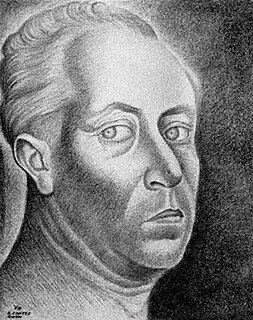
Erasto Cortés Juárez was a Mexican artist and a founding member of the Salón de la Plástica Mexicana.
Zalathiel Vargas is a Mexican artist best known for his work in underground comix and illustrations. His work follows a number of the characteristics of comix including explicit sexuality and psychedelic imagery, but is distinguished by influence from Mexican “photo-novels” and strong social and political messages. His work has been exhibited in Mexico and abroad in venues such as the Palacio de Bellas Artes and the Museo de Arte Moderno as well as a retrospective at the Museo Universitario del Chopo of the Universidad Nacional Autónoma de México.

Francisco I. Madero Avenue, commonly known as simply Madero Street, is a geographically and historically significant pedestrian street of Mexico City and a major thoroughfare of the historic city center. It has an east–west orientation from Zócalo to the Eje Central. From that point the street is called Avenida Juárez and becomes accessible to one-way traffic from one of the city's main boulevards, the Paseo de la Reforma.





















